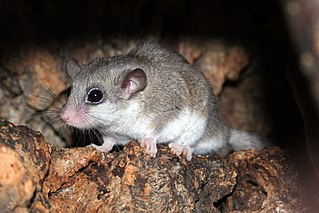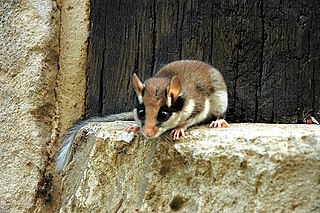
A dormouse is a rodent of the family Gliridae. Dormice are nocturnal animals found in Africa, Asia, and Europe. They are named for their long, dormant hibernation period of six months or longer.

Eliomys is a genus of Palaearctic rodents in the family Gliridae, commonly known as garden dormice.
The desert dormouse is a species of rodent in the dormouse family, Gliridae. This species was formerly placed in its own family, Seleviniidae, but it is now considered to be a dormouse, monotypic within the genus Selevinia. It is endemic to Kazakhstan.

The forest dormouse is a species of rodent in the family Gliridae found in eastern Europe, the Balkans and parts of western Central Asia. It is categorized as being of least concern in the IUCN List of Threatened Species due to its wide range and stable population trend. Forest dormice have a diploid count (2n) of 48 chromosomes. Even though this species lives in a variety of geographic locations, its greatest population density is in the forests of central Moldova, in Transcaucasia, and in the mountains of Central Asia. In most other locations, population density of this species is rather low. Population density is dependent on many factors. But the main features that this species depends on for choosing a location are the presence of the appropriate food sources as well as good foliage that can be used for a habitat. The reason why the forests in central Moldova have the highest population density is they provide the largest diversity of food sources which are available throughout the year. This location also provides the best type of foliage for the forest dormice to build their nests as well as swing from branches. The combination of both of these aspects allows for this species to have its highest needs met. Therefore, during mating season they produce offspring who also stay in the same general area when they mature. It makes sense not to move from an area if it is providing for your most basic needs.

Hypnomys, otherwise known as Balearic giant dormice, is an extinct genus of dormouse (Gliridae) in the subfamily Leithiinae. Its species are considered examples of insular gigantism. They were endemic to the Balearic Islands in the western Mediterranean from the Early Pliocene until their extinction around the 3rd millennium BC. They first appeared in the fossil record on Mallorca during the Early Pliocene, presumably as a result to the evaporation of the Mediterranean sea during the Messinian salinity crisis connecting the Balearic Islands with mainland Europe. They later spread to Menorca, and a possible molar is also known from Ibiza. Hypnomys became extinct during the late Holocene likely shortly after human arrival on the Balearics. They were one of only three native land mammals to the islands at the time of human arrival, alongside the shrew Nesiotites and goat-antelope Myotragus.

Leithia is an extinct genus of giant dormice from the Pleistocene of the Mediterranean islands of Malta and Sicily. It is considered an example of island gigantism. Leithia melitensis is the largest known species of dormouse, living or extinct, being twice the size of any other known species.






